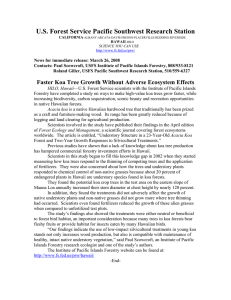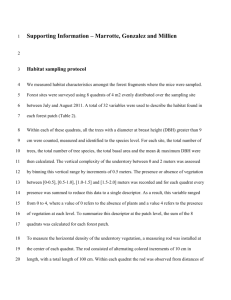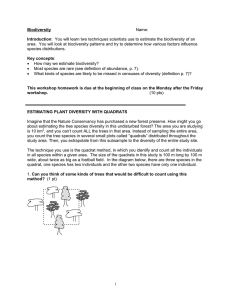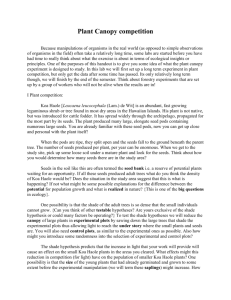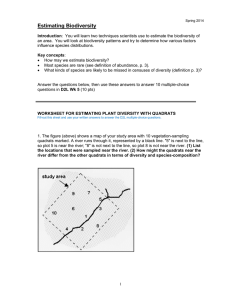PACIFIC SOUTHWEST Forest and Range ExperiIllent Station DISTURBANCE DURING LOGGING
advertisement
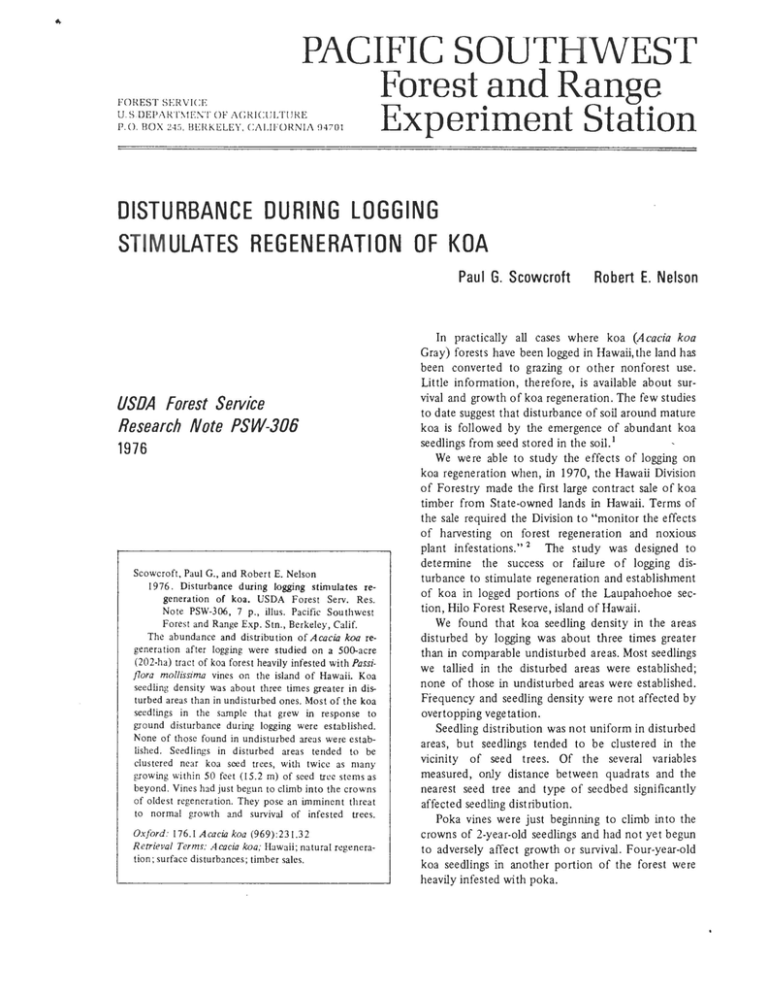
PACIFIC SOUTHWEST Forest and Range ExperiIllent Station FOREST SERVICE U. S.DEI'AR,\,\lE,\;T OF ACR.ICULTI)RE P.O, HOX 24:;, HEHKELEY. CAI.IFORNIA f14701 DISTURBANCE DURING LOGGING STIMULATES REGENERATION OF KOA Paul G. Scowcroft USDA Forest SelVice Research Note PSW-306 1976 Scowcroft. Paul G .• and Robert E. Nelson 1976 . Disturbance during logging stimulates regeneration of koa. USDA Forest Servo Res. Note PSW-306, 7 p., iIIus. Pacific Southwest Forest and Range Exp. Stn., Berkeley, Calif. The abundance and distribution of Acacia koa regenera tion after logging were studied on a 500-acre (202-ha) tract of koa forest heavily infested with Passi/1ora mol/issima vines on the island of Hawaii. Koa seedling density was about three times greater in disturbed areas than in undisturbed ones. Most of the koa seedlings in the sample tha t grew in response to ground disturbance during logging were established. None of those found in undisturbed areus were established. Seedlings in disturbed areas tended to be clustered ncar koa seed trees, with twice as many growing within 50 feet (15.2 m) of seed tree stems as beyond, Vines had just begun to climb into the crowns of oldest regeneration. They pose an imminent threat to normal growth and survival of infested trees. Oxford.' 176. 1 Acacia koa (969):231.32 Retrieval Terms: Acacia koa; Huwaii; natural regeneration; surface disturbances; timber sales. Robert E. Nelson In practically all cases where koa (Acacia koa Gray) forests have been logged in Hawaii, the land has been converted to grazing or other nonforest use. Little information, therefore, is available about survival and growth of koa regeneration. The few studies to date suggest that disturbance of soil around mature koa is followed by the emergence of abundant koa seedlings from seed stored in the soil. I We we re able to study the effects of logging on koa regeneration when, in 1970, the Hawaii Division of Forestry made the first large contract sale of koa timber from State-owned lands in Hawaii. Terms of the sale required the Division to "monitor the effects of harvesting on forest regeneration and noxious plant infestations." 2 The study was designed to determine the success or failure of logging disturbance to stimulate regeneration and establishment of koa in logged portions of the Laupahoehoe section, Hilo Forest Reserve, island of Hawaii. We found that koa seedling density in the areas disturbed by logging was about three times greater than in comparable undisturbed areas. Most seedlings we tallied in the disturbed areas were established; none of those in undisturbed areas were established. Frequency and seedling density were not affected by overtopping vegetation. Seedling distribution was not uniform in disturbed areas, but seedlings tended to be clustered in the vicinity of seed trees. Of the several variables measured, only distance between quadrats and the nearest seed tree and type of seedbed Significantly affected seedling distribution. Poka vines were just beginning to climb into the crowns of 2-year-old seedlings and had not yet begun to adversely affect growth or survival. Four-year-old koa seedlings in another portion of the forest were heavily infested with poka. ments. Only trees of highest merchantable quality were marked for cutting. The logger harvested one compartment at a time, completing the job in 18 months. He used a TD25 crawler tractor with a 13.5foot (4-m) wide blade to ground skid logs and construct landings and roads. About 33 percent of the merchantable koa volume and 26 percent of the ohia volume were removed. Numerous small openings in the forest canopy were created by the removal of marked trees. The ground in these openings was extensively scarified by the bulldozer. Skid trails, which meandered and crisscrossed through the forest, were also sites of extensive ground disturbance. In some places where the bulldozer was just moving to the next felled tree and not pulling logs, few traces of its passage were evident. Naturally occurring openings were not disturbed by logging. Slash piles were numerous. In many cases, unused portions of felled trees were left as they had fallen. STUDY AREA The 500-acre (202-ha) study area lies on the northeast flank of Mauna Kea between 4700- and 5300feet (1433- and 1615-m) elevation. Annual rainfall averages 125 inches (3175 mm). Fog is common during afternoons. Daily temperature averages about 65° F (18° C). Topography is predominantly strongly sloping, with gradients generally between 10 and 30 percen t. Soils in the harvest area have been mapped as Maile, Puu 00, and Piihonua series. 3 Formed in volcanic ash, these soils are well drained. The Maile and Puu 00 series are silt loams with subsoils that dehydrate irreversibly. The Piihonua series consists of silty clay loams that dehydrate irreversibly into fme gravel-sized aggregates. The Piihonua soils are more stony than the Maile or Puu 00 soils and in the study area are characterized by steeper slopes. Under the new Soil Taxonomy, the Maile and Puu 00 are classified as thixotropic, isomesic, Hydric dystrandepts. The Piihonua series is a thixotropic, isomesic, Typic hydrandept. The forest on the study area is a mixed forest of ohia (Metrosideros collina [1. R. and G. Forst.] Gray, subsp. polymorpha [Gaud.] Rock) and koa. The tree canopy covers 40- to 60-percent of the ground. 4 Principal understory species are pilo (Coprosma sp. J. R. and G. Forst.), olapa (Cheirodendron trigynum [Gaud.] Heller), ohelo (Vaccinium calycinum Sm.), tree fern (Cibotium chamissoi Kaulf. and C. splendens [Gaud.] Krajina), arna'u (Sadleria sp.), and puu-Iehua (Microlaena stipoides [Labill.] R. Br.). In the undisturbed forest, koa seedlings are scarce, but ohia seedlings are abundant. Numerous openings up to several acres in size are found throughout the study area. In these openings, arna'u, puu-Iehua, and knotweed (Polygonum glabrum Willd.) are the most abundant species. Blackberry (Rubus penetrans Bailey), an undesirable introduced plant, is found in some openings, and is becoming more widely established. Banana poka (Passi/1ora mollissima [HBK] Bailey), an undesirable, vigorous climbing vine, is abundant. This introduced species produces abundant seed, and has become a serious pest. The vines, which climb to 70 feet (21 m) or more, drape themselves over trees and other plants. METHODS To assess the effects of the disturbance, we set up line transects 6 months after logging was completed. A straight fenceline running the length of the northwest side of the sale area-a distance of 6000 feet (1829 m)-was selected as the base line. Seven straight-line transects were established per 1000 feet (305 m) of base line. Starting points were chosen randomly. About 29 miles (47 km) of transects were set perpendicular to the base line to intercept the greatest number of different site conditions. Along each transect the lengths of intercepted disturbed and undisturbed segments were measured and recorded. A disturbed segment was one along which the litter and humus or underlying mineral soil or both had been mechanically rearranged by the movement of machinery or logs. Undisturbed segments were those showing no evidence of logging activity. Transect segments having slash concentrations were classed as undisturbed if the forest floor beneath had remained essentially undisturbed. This classification was used because experience has shown that ground disturbance is a prerequisite for germination of koa seed stored in the soil. All transects were used to determine the proportion of ground in the sale area actually disturbed by logging. Two of the seven transects in each compartment were selected at random and sampled to gather detailed information about koa reproduction. Along these transects, 4-foot (1.22-m) square quadrats were randomly established within disturbed segments only. A total of 369 quadrats were examined. We recorded THE HARVEST The Division of Forestry administered the timber sale. In spring 1971, it flagged the boundaries dividing the study area into 12 equal administrative compart- 2 and 2 had been disturbed, while slightly over one-half of stratum 3 had been disturbed. The pattern of disturbance (road, skid trail, and landing locatio'ns) was irregular, depending on topography, tree locations, and discretion of the operator. Seedbed Classes Five seedbed classes were recognized in disturbed areas: litter/humus, bare soil, slash (from logging), rock, and vegetated (table 1). About 36 percent of the 369 quadrats examined were classed as bare soil 3 I percent as litter/humus, and 24 percent as vege~ tated. Table I-Percent of seedbed classes in each stratum Seedbed classes Stratum Litter/ humus I 2 3 (::::::::;:::::::: 1 Stratum 1 1\\\\\\\\1 Scale All Stratum 2 ~ Stratum 3 32 50 26 31 I Bare soil 32 2 47 36 I Slash 12 0 1 4 I Rock 7 6 4 5 I Vegetated 17 42 22 24 2000 f eet (6 10 meters) Koa Seedling Abundance Estimates of koa seedling densities in undisturbed portions of the study area were developed in a separate study,4 conducted in 1971 and 1973. Estimates were based on permanent 2-foot (O.6-m) square quadrats randomly located in the study area. In that earlier study, 1862 undisturbed quadrats contained 44 koa seedlings or an average of 257 per acre (635 per ha). 4 After logging, only 1037 quadrats remained undisturbed, and these contained 34 seedlings or 361 per acre (892 per ha). None of the seedlings that had been tallied as alive in 1971 were alive in 1973. All of the seedlings recorded in both years were probably no more than 2 months old because the cotyledons were still attached to some and all were less than 3 inches tall (jig. 2). Rooting by feral pig and intolerance of shade by koa are probably the two agents most responsible for high mortality in natural koa regeneration. Fig. 1-Sampling strata in the 50()..acre (202-hal study area of the Laupahoehoe section, Hila Forest Reserve, island of Hawaii. data on (a) koa seedling counts, (b) predominant seedbed class, (c) position of the nearest koa tree capable of bearing seed relative to the quadrat, (d) quadrat position relative to the topography, (e) maximum and minimum koa seedling heights, and (f) type and degree of banana poka infestation of koa seedlings for each quadrat. When a quadrat was shaded by a tree crown directly overhead, the tree species was recoTded. For data analyses, we divided the sale area into three strata on the basis of time between the end of the logging and the establishment of the sample quadrats (jig. 1): Stratum I 7-12 months Stra tum 2 13- I 8 months Stratum 3 19-24 months An estimated 841 koa seedlings per acre (2078 per ha) occurred in disturbed portions of the study area (table 2). Although a high mortality rate is associated with koa regeneration, other studies have found tens of thousands of seedlings per acre shortly after ground disturbance. I Therefore, the threefold increase over densities in the undisturbed forest was much less than expected. The unexpected small increase in density was more than compensated for by 2 12 acres (86 ha) 82 acres (33 Ita) 206 acres (83 ha) RESULTS Area Disturbed Logging activities disturbed the ground surface in 41 percent of the area. Nearly one-third of strata 1 3 Table 2-0ccu"ence of koa seedlillgs ill Laupahoehoe logging area, Hila Forest Reserve, by disturbance class and by stratum Disturbance class and stratum Undisturbed :1 I 2 3 All After loggingdisturbed : 1 2 3 All Quadrats Quadrats stocked Seedlings Tallied 522 310 618 1450 percent 1 3 3 2 5 10 24 39 118 54 197 369 17 13 18 17 28 9 77 114 I Per acre 104 (257)1 351 (867) 423(1045) 293 (724) 646(1596) 454(1122) 1064(2629) 841(2078) 1 Units in parentheses are hectares. lScowcroft, Paul. 1971. Study plan to determine the effect of logging on the vegetation of the ohia-koa forest. 23 p. Unpublished report on file, Pacific Southwest Forest and Range Experiment Station, Honolulu, Hawaii. the fmding tha t almost all seedlings tallied were well established (fig. 3). By "established" we mean seedlings that were taller than the surrounding herbaceous vegetation, vigorous, and in little danger of being eaten or uprooted by pigs. Fig. 2-Typical of kOIl regeneration in the undisturbed forest, this 2·inch seedling will likely succumb to root· ing by feral pigs or to other adverse influences. Fig. 3-Most kOIl reproduction in disturbed logging areas waS established as shown by these 1.5-year-old seedlings. 4 These analyses were based on seedling density data, but those data were segregated by presence or absence of koa seedlings on individual quadrats. By including unstocked quadrat data in the analysis, significant differences were apparent where none previously existed. The implication is strong that frequency is Significantly lower for quadrats with vegeta ted, seedbeds than for those with bare soil or litter/humus seedbeds. Similarly, quadrats with rock seedbeds are less likely to be stocked than those with slash seedbeds. Within the limitations of the data, seedbed condition did not influence clustering of the seedlings. Frequency was affected by location of seed trees relative to the quadrats. About 23 percent of the quadrats located within 50 feet (I5.2 m) of the stem of a koa seed tree were stocked with koa seedlings, while only 9 percent of the quadrats lying more than 50 feet from a seed tree were stocked (table 4). Seedling density was more than twice as great for quadrats within 50 feet of a seed tree as for quadrats which lay at greater distances. 'This difference, which was computed by using stocked and unstocked quadrat data, was statistically significant, at the 5 percent level. Seedling density for the two categories was not significantly different when only stocked quadrat data were used. Slope position of the nearest koa tree capable of bearing seed relative to the sample quadrat did not affect frequency or seedling density (table 4). The topographical position of quadrats-on a ridge, side slope, or in a drainage bottom-as it affects frequency and seedling density was also examined (table 5), Frequency was 18 percent for quadrats located on a ridge, 20 percent for those on a side slope, Distribution of Koa Seedlings The percent of quadrats in which koa seedlings occurred - hereafter referred to as "frequency"-was a gross measure of distribution. Within disturbed portions of the study area, frequency averaged 17 percent as compared to 2 percent for undisturbed areas (table 2). Seedlings in both disturbed and undisturbed areas were contagiously distributed. They tended to cluster in the vicinity of koa seed trees. The distribution of quadrats by seedling density followed a Poisson curve-more than 80 percent of the sample quadrats in disturbed and undisturbed areas were unstocked. Distribution of seedlings in disturbed areas was slightly affected by seedbed condition (table 3). Frequency for three of the seedbed classes was similar: i.e., litter/humus, 17 percent; bare soil, 24 percent; slash, 20 percent. Frequency was lower for seedbeds classed as either rock or vegetated. Because the distributions of quadrats by seedling density for the five seedbed classes (table 3) were not "normal," we compared them by nonparametric techniques. The Kruskal-Wallis test when applied only to stocked quadrat data did not show statistically significant differences in seedling density attributable to the type of seedbed. However, when data for unstocked and stocked quadrats were combined, the results showed that type of seedbed did affect seedling density (at the 5 percent level of significance). Additional analysis showed that this significance was due to differences between litter/humus and vegetated quadrats (5 percent level), bare soil and vegetated quadrats (I percent leve!), and slash and rock quadrats (I percent level). Table 3- Distribution of quadrats within each seedbed class, by number of koa seedlings per quadrat Quadrats Seedlings per quadrat 0 1 2 3 4 5 6 7 Total quadrats Frequency Mean density (stocked quadrats) Mean density (all quadrats) Litterl humus vege-I Slash Rock I B~e soil I I I tated 96 13 4 2 0 100 16 5 5 2 I I 0 0 1 12 1 2 0 0 0 0 I 0 116 17 1.6 0.3 131 24 2.2 0.5 15 20 1.7 0.3 5 All classes 17 2 0 0 0 0 0 0 82 4 2 0 0 0 0 307 36 13 7 2 2 1 0 1 19 10 1.0 0.1 88 7 I.3 0.1 369 17 1.8 0.3 Table 4 -Distribution of quadrats within seed tree distance classes and topographirol position categories, by number of seedlings per quadrat Quadrats Slope position of ne ares t seed tree from quadrat 1 Distance of nearest seed tree from quadrat Seedlings per quadrat 0-25 ft. (0·7.6 m) 0 I 2 3 4 5 6 7 51+ ft (15 .3+ m) 86 16 6 3 I 0 I 0 147 7 4 1 0 2 0 0 52 11 4 2 1 0 1 0 161 9 2.0 0.2 71 27 1.8 0.5 74 13 3 3 1 0 0 I Total quadrats Frequency Mean density (stocked quadrats) Mean density (all quadrats) 1 Positions 26·50 ft (7.7·15.2 m) 113 24 95 22 1.9 0.4 1.7 0.4 Level 81 14 4 4 1 0 0 I 105 23 1.9 0.4 Down· hill 27 4 I 0 0 0 0 0 32 16 1.2 0.2 of seed trees lying more than 50 feet (15.2 m) from a quadrat not determined. and 13 percent for those in a drainage bottom. Topographical position did not affect seedling densities. (13 cm) for stratum I; 37 inches (94 cm) for stratum 2; and 27 inches (69 cm) for stratum 3. All seedlings tallied were taller than adjacent competing understory vegetation-even those only a few inches tall. Seedling Heights The average height of the tallest koa seedlings on each quadrat was 7 inches (18 cm) for stratum I, 7 to 12 months after logging; 42 inches (I07 cm) for stratum 2, 13 to 18 months after logging; and 41 inches (104 cm) for stratum 3,19 to 24 months after logging. The mean minimum heights were 5 inches Poka Occurrence Banana poka seedlings and vines occurred on about 80 percent of the sample quadrats, However, poka vines were found on koa regeneration only in stra tum 3, where logging had ended 19 to 24 months earlier. In stratum 3, 23 percent of the stocked quadrats had poka vines clinging to the stems of koa regeneration. The vines had grown into the crown of only one koa, an exceptionally tall 15·foot (4.6-m) sapling about 40 percent covered by poka vines. We saw poka in the crowns of other koa regeneration outside our quadrats. Table 5-Quadrat stocl..'"ing with koa seedlings, by topographic position of the quadrat Quadrats Seedlings per quadrat 0 I 2 3 4 5 6 7 Uphill Ridge 44 8 2 0 0 0 0 0 Total quadrats 54 Frequency 18 Mean density (stocked quadrats) 1.2 Mean density (all quadrats) 0.2 I slope Side I Bottom 114 15 8 4 0 2 0 0 149 13 3 3 2 0 1 143 20 1.8 0.4 172 13 2.1 0.3 Overtopping Vegetation We exarrtined the influence of overtopping vegeta· tion on occurrence of koa regeneration in the quadrats. Only 37 percent (136) of the 369 quadrats had forest canopy directly overhead. Frequency for overtopped and nonovertopped quadrats was almost identical: 16.2 and 17.2 percent, respectively. Of the 62 stocked quadrats, 22 were overtopped by the for· est canopy. Of the 136 overtopped quadrats, 25 percent were overtopped by koa, but only 29 percent of these were 6 of man-caused ground disturbance for regenerating koa is evident. The problem of poka competition still persists, however. But poka is more subject to control in the case of planned disturbance than in the case of isolated, widely scattered natural disturbance, i.e. windthrow of single trees. Obviously it is not feasible to send crews through the forest looking for random wind thrown trees just to remove poka from koa regeneration that may be growing in the openings. But poka control in a discrete area with a high concentration of koa regeneration is both feasible and reasonable. stocked with koa seedlings. The average seedling density per quadrat varied little between overtopped (1.7) and nonovertopped (1.9) conditions. DISCUSSION Koa was probably a self-sustaining component of Hawaii's forests from the earliest times. When koa trees fell over they were replaced by either seedlings or root sprouts growing from the dislodged mass of soil and roots or from adjacent areas opened to sunlight. However, elements have been introduced into the environment which severely restrict the natural long-term one-to-one replacemen t. On the island of Hawaii, interference is particularly great from feral pigs and in some areaS from banana poka. Most koa seedlings will be eaten or uprooted by foraging pigs. Only those inaccessible to these animals are likely to survive the seedling stage. Those that do survive may have to compete with banana poka, which flourishes in full sUnlight. Our observations show that koa, despite its rapid growth when young, cannot outgrow poka vines. Consequently, one-to-one replacement is not likely under the not-so-pristine forest conditions now prevalent. This study has shown that the disturbance accompanying logging will stimulate regeneration of koa in quantities large enough to preclude total destruction by pigs. Seedling densities 1-1/2 to 2 years after disturbance were averaging nearly 1100 stems per acre in disturbed areas as compared to about 400 per acre in undisturbed areas. When coupled with the fact that most of the seedlings were established in disturbed areas but none in undisturbed areas, the significance NOTES 1 Judd, C. S. 1920. The koa tree. The Hawaiian Forester and Agriculturist. 17(2):30-35. Lamoureux, Charles H. 1971. Some botanical observations on koa. Hawaiian Botan. Soc. Newsletter 10(1):1-7. Vogl, R. J. 1969. The role of fire in the evolution of the Hawaiian flora and vegetation. Proc. Annu. Tall Timbers Fire Eco!. Conf., Tallahassee, Fla., No.9, p. 5-60. Whitesell, Craig D. 1964. Silvical characteristics of koa (Acacia ko" Gray). USDA Forest Serv. Res. Paper PSW-16, 12 p. Pacific Southwest Forest and Range Exp. Stn., Berkeley, Calif. 2 State of Hawaii. 1971. Conservation district use application HA·71/1/28-175. for timber harvesting at Laupahoehoe. Hawaii. TMK: 3-7-01:02, by the Div. For., Dep. Land and Nat. Resour., March 12, 1971. Approved by Board of Land and Nat. Resour., Honolulu, Hawaii, March 12, 1971. 3 U.S. Department of Agriculture. 1973. Soil survey of the island of Hawaii, State of Hawaii. 115 p. 4 Scowcroft, Paul. 1971. Study plan to determine the effect of logging on the vegetation of the ohia-koa forest. 23 p. Unpublished report on fIle, . Pacific Southwest Forest and Range Exp. Stn., Honolulu, Hawaii. The Authors ___________________________________________ PAUL G. SCOWCROFT is conducting research on the ecology and silviculture of native Hawaiian forests, with headquarters in Honolulu, Hawaii He holds B.S. (1964) and M.S. (1966) degrees in forestry from the Univer-' sity of Missouri. He joined the Forest Service in 1965. ROBERT E_ NELSON heads the Station's Institute of Pacific Islands Forestry, headquartered in Honolulu, Hawaii He joined the Forest Service in 1941, after earning a forestry degree at the University of California. U.S. Forest Service research in Hawaii is cond uc ted in coopera tion wi th Division of Forestry Hawaii Department of Land and Natural Resources 7
